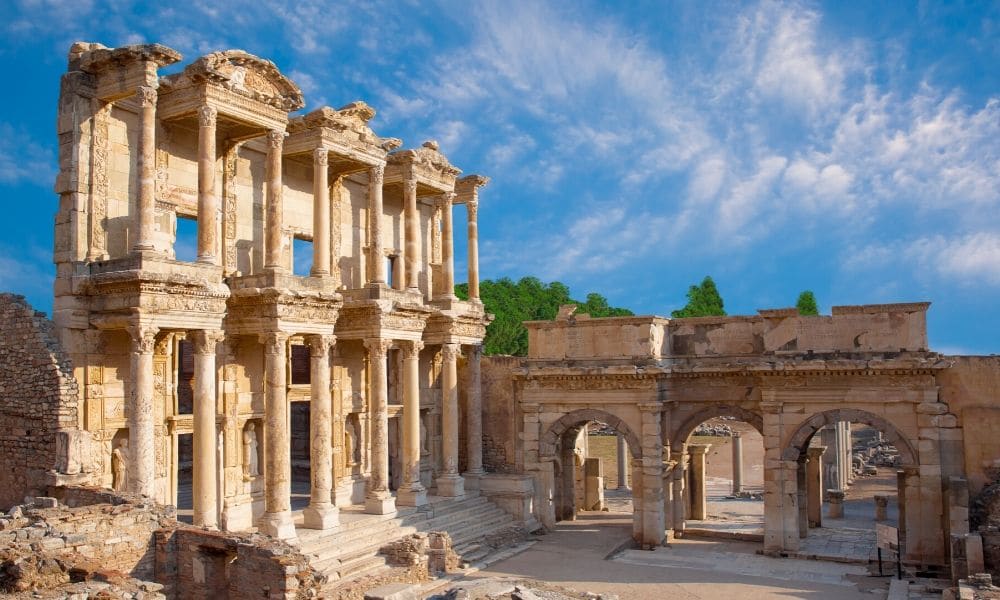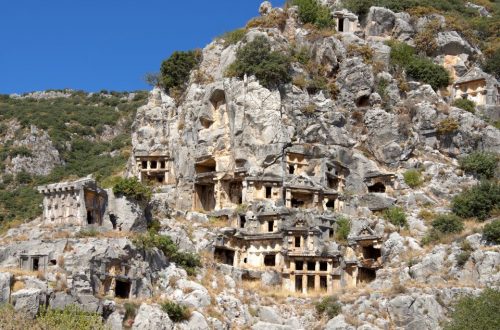
7 Extraordinary Stories from Ancient Turkey
Was he betrayed by Amazon women warriors from Anciant Turkey ? Is it true that Julius Caesar was kidnapped?
And where did the flame from the first Olympic Games come from?
I will tell you seven true, extraordinary facts from Ancient Turkey
1. Pirates kidnapped Julius Caesar on the Aegean coast
The young Gaius Julius Caesar was kidnapped before his great career as a field marshal for the Roman army.
Sicilian pirates attacked his ship on his way to Rhodes. They kept him prisoner in a small cave along the Turkish Aegean coast.
The pirates sent a ransom note to Rome.
Caesar’s response to the ransom demands wounded the pirates.
He got angry because the ransom amount was far too low. The pirates shouldn’t have done that.
After his release, Caesar returned to the pirate hideout with a small army. He captured the pirates and later crucified them.
Another incident from Caesar’s life took place in north-east Anatolia: it was there that he uttered his famous words: “Veni, Vidi, Vici”! – “I came, I saw, I conquered!” which Caesar wrote to the Roman Senate after the battle of Zela.
2. The flame from the first Olympic Games came from the Chimera-Yanartas gas field in Cirali
The Chimera-Yanartas gas field has been burning on the Lycian coast in the seaside resort of Cirali for the past 2,700 years. This has been proven by inscriptions on the ruins, a Greek temple next to the Chimera.
The legend of the Chimera is Turkey’s song of the Nibelungs. It is about the king’s son Bellerophon and the monster Chimera.
The Chimera was able to spit fire like a dragon. The exiled prince Bellerophon killed it.
The death of the Chimera triggered an earthquake that buried his body under the tumbling stones. Since then, the blazing flames from his rotting body have risen fromthat very spot.
It has been said that the Chimera lit for the first Olympic flame in ancient Greece. This is what some traditional stories say.
3. Alexander the Great cut the Gordian knot in Ankara
Alexander the Great and the Gordian Knot: I’ve known this story since school days. Where the city of Gordion is, I do not know.
The ruins of Gordion are near the Turkish capital city of Ankara.
Alexander the Great visited here 2,300 years ago on his way to campaigning in the east.
His goal: the Gordian knot.
It was linked to a prophecy:
“Whoever opens the Gordian Knot shall rule the world”.
Alexander tried to untie the knot. He didn’t succeed. Instead, he cut it with his sword. Violence was a solution in this case.
After that, he conquered Persia, Egypt and the north of India.
4. Two of the Seven Wonders of the World are in Turkey
King Mausolos succeeded in creating the model for monumental tombs: the mausoleum of Helicarnassus.
The word “mausoleum” is linked to it.
In ancient times, people thought that they should aspire to attain immortality.
King Mausolos succeeded in building his tomb. The word mausoleum has been adopted in dozens of languages.
The structure itself has not survived so well over the past millennia. You can find its sparse remains in downtown Bodrum.
The second ancient wonder of the world is the Artemis Temple. In its day, it was considered the most magnificent sanctuary in the world.
People came from all over the world to Ephesus to see it. Nothing has changed in the two thousand years after it was built. Ephesus is still one of the most visited sights in all of Turkey.
Every day, cruise ships with thousands of visitors dock at the port of Kusadasi. Your destination is Ephesus with its Artemis temple, the Celsus library and the gigantic theatre.
5. The Egyptian pharaoh Cleopatra ruled part of Ancient Turkey
After the death of Julius Caesar, Cleopatra found a new lover in Marcus Antonius.
Antony gave Cleopatra a part of the Turkish south coast. It includes today’s Alanya – formerly known as Korakesion.
The story still provides a good template for promoting tourism in this coastal city.
Cleopatra is said to have brought sand from the Sahara to Alanya to bathe by the sea. A small bay on Alanya Castle Hill is named after her. And of course, there is Cleopatra Beach: complete with the alleged sand from the Sahara.
Alanya’s Cleopatra Beach doesn’t really need such stories. It already attracts plenty of bathers.
In Alanya there are beaches even more beautiful than Cleopatra Beach.
6. The oldest temple in the world is in Turkey
The 12,000 year old Göbekli tepe changed our view of human history. So say the excavation managers of the German Archaeological Institute.
Since the 1990s, they have been uncovering the Stone Age mountain sanctuary of Göbli Klitepe in Southeast Anatolia.
Göbekli tepe was built even before the people of Mesopotamia settled down.
Believe it or not, Stonehenge is 7,000 years its junior. The Giza pyramids were built 8,000 years later. The temple complexes in Angkor Watt were built 11,000 years after Göbli Klitepe.
Göbekli tepe proves a theory:
When we were still nomads, we built temples and necropolis. This was long before we thought about settling down in cities.
Because of this knowledge, Göbekli tepe is one of the most important archaeological sites in the world.
And only a small portion of it has been explored.
7. Amazons ruled part of the Black Sea coast in Ancient Turkey
Jason was the first sailor to sail the Bosphorus Sea in his search for the Golden Fleece.
Then he set a course with his ship along the Black Sea coast, to the east. He brought it to the Hazelnut Coast, near Trabzon.
In the city of Onea in Ancient Turkey (today Üniye) Jason met the descendants of the Amazons of Lemnos. They are said to have been of great help to him in his search for the Golden Fleece.
Greek-Turkish history has some references to the Amazons of Ünye. They are believed to come from a Neolithic, matriarchal tribe that settled on the coast 4,000 years ago.
The Amazons on the Thermodon River in Üniye have been mentioned, for example, in the epic of Troy by Homer.
The last time they appeared was in the 14th century. A Byzantine woman led the defence of Onea against the Ottoman troops.
The Byzantines lost the battle against the Ottomans. Apparently, this could only be possible through the betrayal of the inhabitants of Onea to their general. Perhaps she was an Amazon?
Bonus: The Iliad and the ruins of the fabled city of Troy
Troy: The legendary city from Homer’s Iliad.
In the past century, the German archaeologist Heinrich Schliemann found the ruins of Troy. Nobody believed in him then.
That changed suddenly with the discovery of Troy and the treasure of Priam.
Excavations of the ruins of Troy have continued since Schliemann’s discovery in the 19th century. You can see them at the southern entrance to the Dardanelles Strait.
Perhaps, in the old stones, there are still references to Achilles, Hector, Paris and the beautiful Helena?
The easiest way to find out is to combine a visit to Troy with a city excursion of Istanbul.
Every day, fast ferries run to Canakkale in three hours. From there, Troy is only a few minutes away.
Do you know any extraordinary stories from ancient Turkey? Share them!




